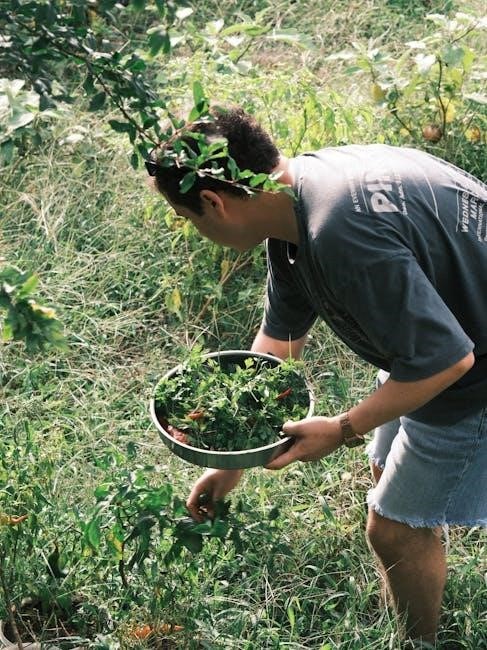permaculture manual
Summary
Discover practical permaculture tips, sustainable techniques, and eco-friendly strategies in our comprehensive manual. Start your journey today!

Permaculture is a holistic design system enhancing ecosystems while promoting sustainable living. It integrates ethics like Earth care and fair share, guiding harmonious land use and resource management.
1.1 Overview of Permaculture and Its Importance
Permaculture is a holistic design system that aims to create sustainable and self-sufficient ecosystems by integrating natural landscapes with human needs. It emphasizes ethical land use, biodiversity, and resource conservation, ensuring long-term productivity. This approach is vital for addressing environmental challenges, promoting food security, and fostering resilient communities. By mimicking nature, permaculture offers practical solutions for sustainable living, making it a cornerstone of ecological design and regenerative practices worldwide.
1.2 History and Evolution of Permaculture
Permaculture emerged in the 1970s, developed by Bill Mollison and David Holmgren, as a response to environmental degradation and resource depletion. Inspired by natural ecosystems, it aimed to create sustainable agricultural systems. The term “permaculture” blends “permanent agriculture” and “permanent culture,” reflecting its goal of harmonizing human needs with nature. Over time, it evolved from a farming technique into a global movement, integrating design principles, ethics, and community-building practices. Today, permaculture is applied worldwide, adapting to diverse climates and cultures while promoting ecological balance and resilience.

Core Concepts of Permaculture
Permaculture integrates ethics, design principles, and natural patterns to create regenerative systems. It emphasizes harmony with nature, resource efficiency, and holistic approaches to sustainable living and land management.
2.1 The Three Ethics of Permaculture
Permaculture is grounded in three core ethics: Earth Care, People Care, and Fair Share. Earth Care emphasizes stewardship of natural resources and ecosystems. People Care focuses on meeting human needs while fostering community well-being; Fair Share promotes equitable distribution of resources and recognition of nature’s limits. These ethics guide sustainable practices, ensuring regenerative systems benefit all life. By integrating these principles, permaculture creates balanced, productive environments that support biodiversity and human prosperity. They form the moral foundation for designing harmonious landscapes and communities.
2.2 The Twelve Design Principles
The twelve design principles of permaculture are foundational guidelines for creating sustainable systems. They include observing and interacting with nature, catching and storing energy, obtaining a yield, and using renewable resources. These principles encourage efficient resource use, waste reduction, and biodiversity promotion. By following these ethical guidelines, permaculture designs aim to create regenerative, self-sustaining ecosystems that benefit both people and the planet. Each principle builds on the ethics, ensuring systems are productive, resilient, and harmonious with nature.

Permaculture Design Process
The permaculture design process involves systematic planning and implementation. It begins with site analysis, followed by base mapping and sector planning, ensuring efficient resource use and biodiversity.
3.1 Site Survey and Analysis
A site survey and analysis are the foundation of permaculture design. It involves observing the landscape, identifying slopes, water flow, and existing vegetation. Key steps include mapping sectors, assessing microclimates, and noting soil types. This process helps designers understand the site’s potential and limitations. By analyzing these elements, a comprehensive base map is created, guiding the placement of plants, water systems, and structures. This step ensures the design aligns with nature, optimizing resource use and fostering sustainability. Proper analysis leads to efficient and regenerative land management.
3.2 Creating a Base Map and Sector Analysis
Creating a base map is essential for permaculture design, providing a detailed visual representation of the site. It includes boundaries, slopes, water sources, and existing vegetation. Sector analysis divides the site into zones based on environmental factors like sunlight, wind, and access. This process helps identify optimal placement for plants, water systems, and structures. By aligning elements with natural patterns, the design becomes efficient and regenerative, ensuring resources are used wisely and the ecosystem thrives. A well-executed base map and sector analysis are key to a successful permaculture project.
3.4 Implementing the Design in Phases
Implementing a permaculture design in phases ensures a gradual and sustainable transformation of the site. Start with essential elements like water management and soil preparation. Prioritize planting beneficial species and building key infrastructure. Later phases focus on adding diversity, such as fruit trees and animals. Regular monitoring and adjustments are crucial to adapt to changing conditions. This stepped approach minimizes overwhelm and allows the ecosystem to evolve naturally, ensuring long-term productivity and resilience.
Key Components of a Permaculture System
Permaculture systems integrate diverse components like plants, water management, soil conservation, and biodiversity. These elements work together to create efficient, sustainable, and productive ecosystems through harmonious interactions.
4.1 Plants and Their Roles in the System
Plants form the backbone of a permaculture system, serving multiple functions such as soil erosion prevention, nutrient cycling, and food production. They enhance biodiversity by attracting pollinators and beneficial insects. Nitrogen-fixing plants like legumes improve soil fertility, while fruit trees and berries provide sustenance. Companion planting and guilds are used to create symbiotic relationships, maximizing productivity. Each plant is chosen for its ability to support the ecosystem, ensuring a balanced and resilient system that thrives with minimal external inputs.
4.2 Water Management Strategies
Effective water management is crucial in permaculture, focusing on conservation, efficient use, and sustainable harvesting. Techniques include mulching to reduce evaporation, swales to capture and store rainwater, and ponds to create reservoirs. Irrigation systems are designed to deliver water directly to plant roots, minimizing waste. Rainwater harvesting systems collect and store water for various uses, ensuring resource availability during dry periods. These strategies aim to maximize water retention in the landscape, supporting biodiversity and productivity while reducing reliance on external water sources.
4.3 Soil Conservation and Improvement Techniques
Soil health is foundational to permaculture, with techniques like mulching, composting, and cover cropping enhancing fertility and structure. Mulching retains moisture and suppresses weeds, while compost adds organic matter, improving soil biota. Cover crops prevent erosion and replenish nutrients. No-till or reduced-tillage methods minimize soil disturbance, preserving its structure and carbon content. These practices promote long-term soil productivity, biodiversity, and resilience, ensuring a sustainable foundation for permaculture systems.
Case Studies and Examples
Explore real-world permaculture successes, from thriving farms like Liz’s sustainable landscapes to urban projects transforming communities, showcasing biodiversity, food security, and ecological restoration through practical applications.
5.1 Successful Permaculture Farms and Their Stories
Discover inspiring tales of permaculture farms thriving globally. Liz’s permaculture farm showcases biodiversity and self-sufficiency, while Marie and Ben’s Notion Mastery demonstrates innovative land management. These farms highlight effective techniques like polycultures, water harvesting, and agroforestry, proving permaculture’s adaptability. From small-scale homesteads to large regenerative projects, these stories illustrate how permaculture fosters resilience, enhances ecosystems, and builds community. Each farm’s journey reveals unique challenges overcome through sustainable practices, inspiring others to adopt similar methods for a greener future.
5.2 Urban Permaculture Projects and Their Impact
Urban permaculture initiatives are transforming cities worldwide by creating sustainable, productive spaces. Projects like community gardens and rooftop farms demonstrate how permaculture principles adapt to urban environments. These efforts reduce carbon footprints, improve air quality, and provide fresh produce to residents. For example, a Seattle-based project turned vacant lots into thriving ecosystems, engaging hundreds of volunteers. Such initiatives foster community collaboration, educate citizens on sustainable living, and showcase the viability of permaculture in densely populated areas, inspiring broader environmental and social change.

Making Permaculture Accessible
Permaculture accessibility involves sharing knowledge and resources widely. Online communities, free manuals, and workshops democratize learning, enabling individuals worldwide to adopt sustainable practices regardless of location or background.
6.1 Funding Your Permaculture Project
Funding a permaculture project requires creativity and resourcefulness. Grants, crowdfunding, and community support are viable options. Government incentives for sustainable agriculture can also provide financial backing. Additionally, partnerships with local organizations or businesses can help secure resources; Many permaculture enthusiasts leverage online platforms to raise funds, sharing their vision and goals. Workshops and educational events can also generate income while spreading awareness. Diversifying income streams ensures long-term sustainability, aligning with permaculture’s ethical principles of fairness and abundance.
6.2 Engaging the Community in Permaculture Initiatives
Engaging the community is essential for permaculture initiatives to thrive. Host workshops, demos, and hands-on activities to educate and empower locals. Online forums and social media can foster connections and knowledge sharing. Collaborative projects, like community gardens, build unity and ownership. Encourage feedback and participation to ensure initiatives align with local needs. By involving diverse stakeholders, permaculture becomes a collective effort, promoting sustainability and resilience. Empowering communities ensures long-term success and widespread adoption of permaculture principles.
Resources and Tools
The cornerstone resource is Bill Mollison’s Permaculture: A Designers Manual, offering comprehensive guidance. Online communities and forums, like Permaculture GPT, provide additional support and practical insights.
7.1 Recommended Reading and Manuals
Essential permaculture manuals include Permaculture: A Designers Manual by Bill Mollison, a cornerstone text detailing ethics, principles, and practical applications. The Edible Forest Garden by Dave Jacke and Eric Toensmeier offers in-depth insights into forest gardening. For backyard applications, Gaia’s Garden by Toby Hemenway provides practical guidance. These resources blend theory with actionable strategies, catering to both newcomers and experienced practitioners. They are indispensable for designing sustainable systems, ensuring a balanced approach to learning and implementation.
7.2 Online Communities and Forums
Online platforms like Permaculture Forums and Reddit’s r/Permaculture offer vibrant spaces for discussion and knowledge sharing. Facebook groups such as Permaculture Worldwide connect practitioners globally. Specialized forums like Permies delve into niche topics, fostering collaboration and problem-solving. These communities provide access to expert advice, personal experiences, and resources, enabling learners to troubleshoot challenges and refine their strategies. Engaging with these forums can enhance your permaculture journey, offering inspiration and practical insights for sustainable living and design implementation.

Troubleshooting Common Challenges
Common challenges include soil degradation, water scarcity, and pest issues. Natural solutions like composting, mulching, and crop rotation can restore soil health and enhance resilience in permaculture systems.
8.1 Managing Pests and Diseases Naturally
Managing pests and diseases naturally is a cornerstone of permaculture. By fostering biodiversity, planting pest-repellent species, and maintaining healthy soil, ecosystems can balance themselves. Companion planting, crop rotation, and introducing beneficial insects like ladybugs or bees can control pests without chemicals. Natural remedies such as neem oil, garlic sprays, and compost tea also help combat diseases. Observing and understanding the lifecycle of pests allows for targeted, eco-friendly interventions. Healthy, diverse systems are more resilient to outbreaks, reducing the need for external inputs and promoting long-term sustainability.
8.2 Addressing Climate and Soil Limitations
Permaculture offers solutions to climate and soil challenges by using natural methods. In arid climates, water harvesting and conservation techniques like swales and mulching are essential. For sloped lands, contour planting and terracing prevent erosion. In poor soils, composting, cover cropping, and organic amendments improve fertility. Climate-resilient plants are selected to thrive in extreme conditions, while agroforestry practices mitigate temperature fluctuations. These strategies ensure productive ecosystems even in challenging environments, promoting sustainability and resilience.
Permaculture offers a transformative path toward sustainable living, fostering resilience and ecological harmony. Its future lies in innovative practices and global adoption, ensuring a regenerative planet for generations.
9.1 The Role of Permaculture in Sustainable Living
Permaculture plays a vital role in sustainable living by offering practical solutions to environmental challenges. It promotes ethical land use, biodiversity, and efficient resource management, fostering self-sufficiency and community resilience. By integrating nature’s patterns into daily life, permaculture empowers individuals and communities to create regenerative systems that enhance ecosystems while meeting human needs. This approach not only addresses climate change but also encourages a mindset shift toward long-term thinking and ecological stewardship, making it a cornerstone of sustainable living for future generations.
9.2 Innovations and Trends in Permaculture
Modern innovations in permaculture include the integration of technology, such as smart irrigation systems and AI-driven design tools like Permaculture GPT. Urban permaculture is gaining traction, adapting principles to city spaces. Regenerative agriculture aligns with permaculture ethics, promoting soil health and biodiversity. New trends emphasize climate-resilient designs and community-driven projects. These advancements make permaculture more accessible and effective, ensuring its relevance in addressing global environmental challenges while fostering sustainable, self-sufficient communities.